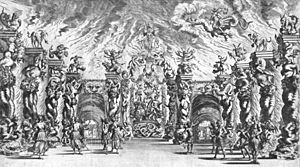Antonio Cesti facts for kids
Pietro Marc'Antonio Cesti (born August 5, 1623 – died October 14, 1669) was a famous Italian composer from the Baroque period. He was also a talented singer (a tenor) and an organ player. Many people thought he was the most celebrated Italian musician of his time.
A Musician's Life
Cesti was born in a town called Arezzo, Italy. He learned music from different teachers there. In 1637, he joined a religious group called the Franciscans, which was founded by Francis of Assisi.
While he was in a town called Volterra, Cesti started to focus more on music for entertainment, not just religious music. This might have been because of the powerful Medici family, who supported artists. He also met a writer named Salvator Rosa, who wrote words (called libretti) for some of Cesti's songs (called cantatas).
By 1650, Cesti's life as a Franciscan friar and his success as an opera singer and composer started to clash. He even got a warning about it. In 1652, he joined the court of Ferdinand Charles, Archduke of Austria in Innsbruck. Later, he worked in Florence as a music director (maestro di cappella). In 1660, he joined the Pope's musical group. By 1666, he became the Vice-Kapellmeister (a high-ranking music director) in Vienna. He passed away in Venice in 1669.
Cesti's Music
Cesti is best known for his operas. Some of his most famous operas include La Dori (first performed in Innsbruck in 1657), Il pomo d'oro (Vienna, 1668), and Orontea (1656).
Il pomo d'oro (which means The Golden Apple) was written for the wedding of Emperor Leopold I in Vienna in 1666. It was first performed in 1668 and was known for being incredibly grand and fancy. It was much more detailed than other operas of that time. It used a large orchestra, many singing groups (choruses), and special machines to make things happen on stage. For example, gods would appear from the sky, or there would be exciting naval battles and storms.
Orontea was very popular and was performed 17 times over the next 30 years. This made it one of the most frequently performed operas in Europe in the mid-1600s. Even the famous writer Samuel Pepys owned a copy of its music. This opera includes a well-known song for a soprano singer called "Intorno all'idol mio" (meaning "Around my idol").
Cesti also wrote many chamber cantatas, which are like short musical stories for a few singers and instruments. His operas are known for their beautiful and gentle singing style, which was perfect for smaller rooms, not just big stages. He wrote in the bel canto style of the 17th century, which means "beautiful singing." His own experience as a professional singer greatly influenced his music. His compositions also showed the new musical idea of tonality, where music has a clear home key.
Main Works
| Title | Libretto | Première date | Place, theatre | Notes |
|---|---|---|---|---|
| Alessandro vincitor di se stesso | Francesco Sbarra | 1651 | Venice, Teatro Santi Giovanni e Paolo | |
| Il Cesare amante | Dario Varotari | 1651 | Venice, Teatro Grimano | |
| Cleopatra | Dario Varotari | 1654 | Innsbruck | revised version of Il Cesare amante |
| L'Argia | Giovanni Filippo Apolloni | 1655 | Innsbruck | |
| Marte placata | Giovanni Filippo Apolloni | 1655 | Innsbruck | |
| Orontea | Giacinto Andrea Cicognini, revised by Giovanni Filippo Apolloni | 19 February 1656 | Innsbruck | revived in Innsbruck in 1982 (René Jacobs) and recorded for HM; revived in Frankfurt in 2015 (Ivor Bolton) |
| La Dori | Giovanni Filippo Apolloni | 1657 | Innsbruck | |
| Venere cacciatrice | Francesco Sbarra | 1659 | Innsbruck | lost |
| La magnanimità d’Alessandro | Francesco Sbarra | 1662 | Innsbruck | |
| Il Tito | Nicolò Beregan | 13 February 1666 | Venice, Teatro Grimano | |
| Nettuno e Flora festeggianti | Francesco Sbarra | 12 July 1666 | Vienna | |
| Le disgrazie d'Amore | Francesco Sbarra | 19 February 1667 | Vienna | |
| La Semirami | Giovanni Andrea Moniglia | 9 July 1667 | Vienna | revised 1674 in Modena as La schiava fortunata |
| La Germania esultante | Francesco Sbarra | 1667 | Vienna | |
| Il pomo d'oro | Francesco Sbarra | 12–14 July 1668 | Vienna | |
| Genserico | Nicolò Beregan | 1669 | Venice |
Recordings
- Pietro Antonio Cesti "Pasticcio", from the Old Music Festival in Innsbruck 1980. This recording includes parts from his operas "Il pomo d'oro", "Argia", "Tito", "Orontea", "Dori", and "Semirami".
- Le disgrazie d’amore, performed by Auser Musici, directed by Carlo Ipata (2010).
- Alma Mia, sung by Raquel Andueza with La Galania (2014). This recording features songs from L'Argia, La Dori, Orontea, Il Tito, and two cantatas.
- L'Orontea by Frankfurter Opern und Museumsorchester, directed by Ivor Bolton (2017).
- La Dori by Accademia Bizantina, directed by Ottavio Dantone (2020).
See Also
 In Spanish: Antonio Cesti para niños
In Spanish: Antonio Cesti para niños
- Baroque opera
- Francesco Cavalli
- Claudio Monteverdi, an older contemporary of Cesti


